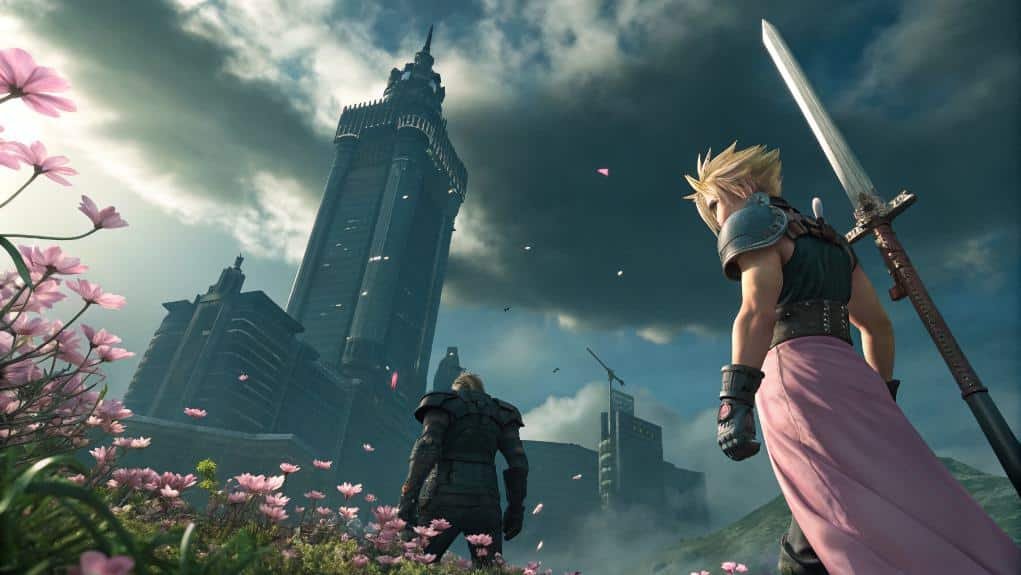The history of Final Fantasy VII is marked by groundbreaking achievements and profound narrative complexity. Initially released in 1997, it revolutionized the RPG genre with its vivid 3D graphics and compelling storytelling. Central events, like Jenova's arrival and the Nibelheim Incident, shaped character arcs and overarching themes, reflecting eco-terrorism and capitalism critiques. The game's impact extended into numerous spin-offs and remakes, which have redefined character fates and enriched lore. This ongoing evolution keeps the franchise relevant to both old fans and newcomers alike. Unpacking the narrative intricacies reveals even deeper connections and implications for the beloved series.
Key Takeaways
- Final Fantasy VII (1997) revolutionized RPGs with innovative 3D graphics, real-time battle systems, and deep emotional narratives, creating iconic characters like Cloud and Sephiroth.
- The game's narrative explores themes of eco-terrorism and capitalist critique, resonating with societal concerns of the 1990s and influencing cultural discussions.
- Significant events such as the Wutai War and Nibelheim Incident shaped character backstories and motivations, leading to complex relationships and conflicts within the storyline.
- The franchise expanded through prequels and remakes, including Crisis Core and Final Fantasy VII Remake, offering new perspectives and altering character fates.
- Final Fantasy VII has had a lasting cultural impact, inspiring community engagement through cosplay, fan art, and music, solidifying its legacy in gaming history.
Pre-History and Ancient Events
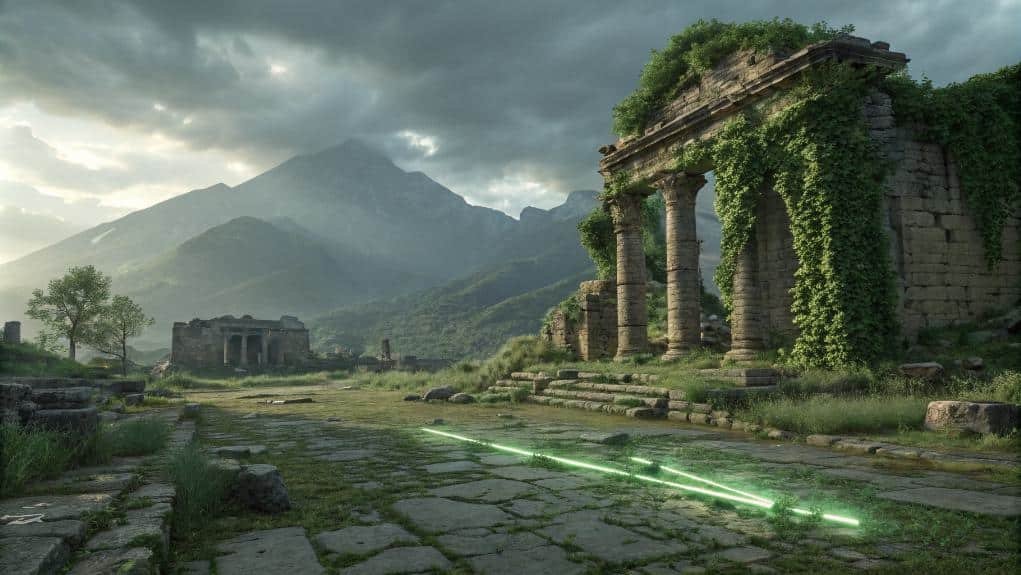
The ancient events that shaped the world of Final Fantasy VII are rooted in a tumultuous history, marked by the catastrophic arrival of Jenova on Gaia. This extraterrestrial being, whose crash resulted in widespread devastation, set off a chain of events leading to the near extinction of the Cetra, the planet's original guardians.
The Jenova influence permeated the land, creating a profound imbalance and compelling the planet to generate Weapons—massive, destructive entities designed to combat the threat posed by Jenova. Weapons were created by the planet to protect itself from the devastation wrought by Jenova.
As the Cetra endeavored to heal Gaia, their ancient knowledge of the Life Stream became essential. This spiritual energy source, critical for the planet's regeneration, faced decline as Shinra exploited it, exacerbating environmental damage.
The impact crater, now known as the Great Northern Crater, became a focal point for both historical legacy and conflict, as remnants of Jenova lingered, embodied in the figure of Sephiroth.
Ultimately, the echoes of these ancient events resonate throughout the narrative of FFVII, illustrating the lasting consequences of Jenova's arrival and the tragic fate of the Cetra, whose wisdom and connection to the planet remain significant in the ongoing struggle for Gaia's survival.
Early Modern Events
Significant transformations unfolded in the early modern era of Final Fantasy VII, profoundly impacting the lives of key characters and the geopolitical landscape of Gaia.
The Wutai War, ignited in 1959, marked a pivotal moment, cementing Sephiroth's status as a decorated hero while entrenching Shinra's influence as it exploited Mako energy for military gain. This conflict deepened social and ecological crises, laying the groundwork for AVALANCHE's formation in the early 1990s. The war's aftermath saw the emergence of the Lifestream's role, which became integral to understanding the environmental consequences of Shinra's actions.
This grassroots organization utilized guerrilla tactics to counteract Shinra's relentless exploitation of Midgar's ecology, which was in dire straits due to corporate greed.
The backstories of characters like Tifa and Aerith intertwine with these events; Tifa's resilience is shaped by her experiences during the war, while Aerith's escape from Shinra underscores her unique Cetra heritage.
Their journeys reflect the broader struggle for conflict resolution amid a fractured world. The late 1990s saw escalating violence, culminating in devastating events like the destruction of Sector 7, showcasing the dire consequences of Shinra's pursuit of power.
These early modern events set the stage for the unfolding narrative, intertwining personal histories with the fate of Gaia itself.
Critical Incidents
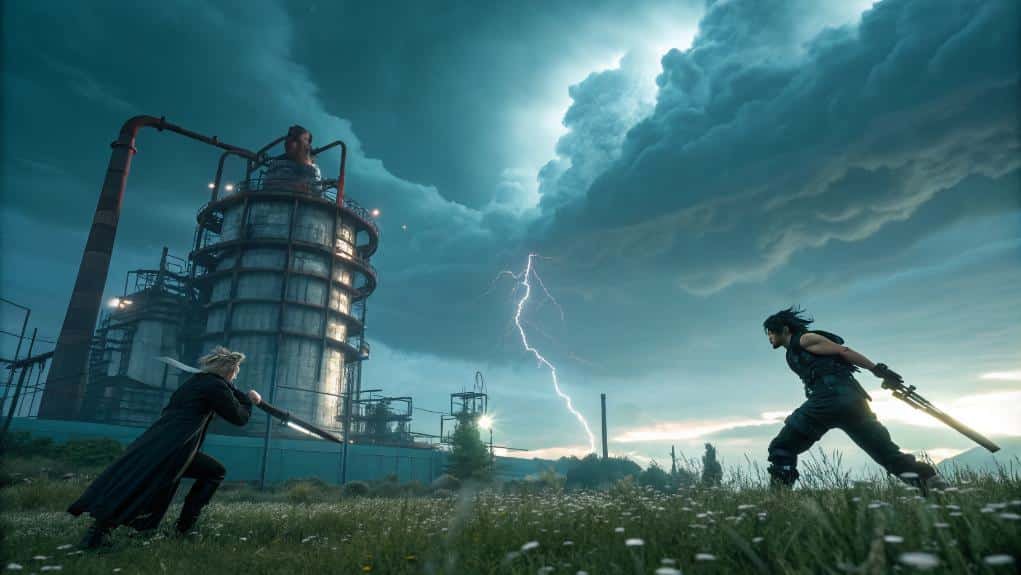
Critical incidents within Final Fantasy VII serve as turning points that not only shape the characters but also redefine the overarching narrative. The Nibelheim Incident, a defining moment, profoundly impacts Cloud and Tifa while marking the beginning of Sephiroth's transformation into a villain. His discovery of Jenova's origins triggers a descent into madness, leading to the tragic death of Tifa's father and the destruction of the town. This critical confrontation between Cloud and Sephiroth is pivotal, setting the stage for future conflicts. The Nibelheim Mission's objective to investigate and neutralize monsters highlights the dangerous environment that ultimately contributes to the chaos that ensues.
The aftermath of this incident resonates throughout the storyline, influencing character motivations and relationships. Cloud's trauma from the event complicates his identity, while Tifa's resolve solidifies her commitment to stop Sephiroth. Additionally, media manipulation by Shinra obscures the true nature of Sephiroth's actions, altering public perception and fueling further narrative shifts.
| Incident | Character Impact | Narrative Shift |
|---|---|---|
| Nibelheim Incident | Cloud's Trauma | Sets up conflict with Sephiroth |
| Sephiroth's Transformation | Tifa's Resolve | Changes Sephiroth's motivations |
| Critical Confrontation | Tifa's loss and determination | Shapes Cloud's identity |
| Aftermath Impact | Legacy of fear and anger | Influences ally dynamics |
| Origins Revelation | Understanding of Sephiroth's past | Unfolds main plot elements
Games in Chronological Order
The timeline of the Final Fantasy VII universe reveals a complex interplay of events that shape its narrative.
Beginning with prequels like "Final Fantasy VII: The First Soldier" and culminating in modern entries such as "Final Fantasy VII Rebirth," each installment builds upon its predecessors, offering followers a rich, interconnected story. Notably, "Crisis Core: Final Fantasy VII" serves as a pivotal entry that delves into the origins of SOLDIER operatives, further enhancing the lore of the series.
Understanding this chronological arrangement not only highlights the game's development progression but also enhances appreciation for its expansive lore.
Timeline Overview
Exploring the timeline of the Final Fantasy VII universe reveals a rich tapestry of interconnected narratives, each contributing to the overarching story. This timeline not only showcases character evolution but also highlights the intricate narrative structure that binds them together.
Here's an overview of the games in chronological order:
| Year Before/After | Title | Description |
|---|---|---|
| 18 years before | Final Fantasy VII: The First Soldier | Focuses on SOLDIER candidates in battle royale. |
| 7 years before | Crisis Core: Final Fantasy VII | Chronicles Zack Fair's story and Sephiroth's rise. |
| 6 years before | Before Crisis: Final Fantasy VII | Follows the Turks and their fight against AVALANCHE. |
| 1997 | Final Fantasy VII | The original game featuring Cloud and Sephiroth. |
| 2020 | Final Fantasy VII Remake | Retells the original story with expanded narrative. |
| 3 years after | Dirge of Cerberus: Final Fantasy VII | Centers on Vincent Valentine and Deepground. |
This timeline not only encapsulates key events but also underscores the dynamic shifts in character arcs as they navigate the complexities of their world. The inclusion of remakes and prequels has significantly broadened the lore, enriching the player's understanding of the narrative context.
Game Development Progression**
Throughout the evolution of the Final Fantasy VII franchise, game development has seen a remarkable progression, marked by innovative storytelling and gameplay mechanics. The original Final Fantasy VII, released in 1997, introduced groundbreaking 3D graphics and real-time battle systems, which greatly enhanced character development through deep narratives and emotional arcs. Characters like Cloud Strife and Sephiroth became iconic, embodying the complex themes of heroism and betrayal.
Following this, Crisis Core and Before Crisis explored the backstories of pivotal characters, utilizing unique game mechanics that emphasized action-oriented gameplay and RPG elements. These prequels enriched the lore leading up to the original game, providing context for character motivations.
The shift to remakes, exemplified by Final Fantasy VII Remake in 2020, showcased an evolution in gameplay mechanics, integrating real-time combat with strategic elements, thereby appealing to both new players and nostalgic fans. The character development was further expanded, allowing for deeper interactions and emotional connections. Additionally, the remakes retain original themes of pro-environmentalism, connecting past narratives with contemporary issues.
As the franchise continues with Rebirth and Ever Crisis, developers push boundaries with episodic storytelling and reimagined narratives, ensuring that the essence of Final Fantasy VII remains relevant while enchanting a new generation.
New Timeline and Changes
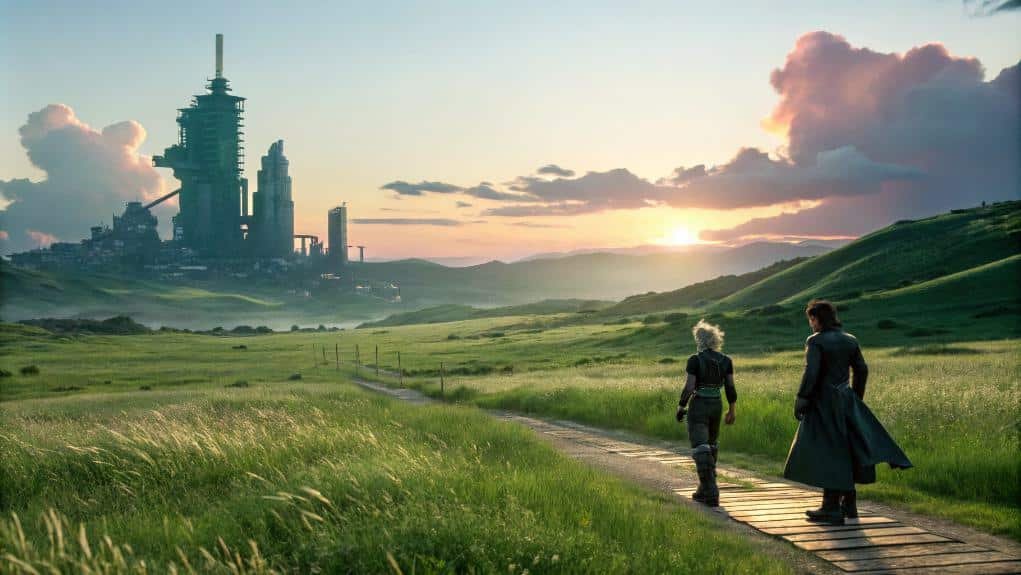
The new timeline established by the Final Fantasy VII Remake greatly reshapes character fates and relationships, particularly highlighting Zack Fair's unexpected survival.
Biggs emerges as a pivotal figure post-Sector 7's destruction, altering the dynamics within AVALANCHE and their ongoing struggle against Shinra. This change in Biggs' fate indicates a potential shift in the group's future interactions and strategies against their adversaries.
Meanwhile, Sephiroth's modified plans suggest a deeper understanding of the timeline's changes, opening the door to unforeseen conflicts and alliances.
Zack's Unexpected Survival
Zack's unexpected survival in the *Final Fantasy VII Remake* marks a pivotal shift in the narrative landscape, reshaping both character dynamics and overarching storylines. The defeat of the Whispers sends shockwaves through time, allowing Zack to evade his tragic fate, which dramatically alters his character arc.
This unexpected twist introduces alternate timeline implications that could fundamentally change the future of the *FF7 Remake* series. Zack's survival not only creates potential conflicts with the original narrative but also opens avenues for him to interact with key characters, like Cloud and Aerith, across timelines.
As Aerith senses Zack's lingering presence, the emotional stakes heighten, complicating existing relationships and love triangles. In addition, Zack could emerge as a potential antagonist, reflecting the dangers of narrative alteration and posing new challenges for the protagonists. Zack's ability to cross timelines may also allow him to aid Cloud during crucial battles, increasing the stakes of their intertwined fates.
The developers at Square Enix have confirmed that Zack's survival will greatly impact the storyline, suggesting a more intricate web of inter-character relationships and conflicts.
With his fate now intertwined with Cloud's, the implications of Zack's presence amplify the complexity and depth of the *FF7 Remake* trilogy, promising an unforgettable journey ahead.
Biggs' New Role
Biggs' survival in the *Final Fantasy VII Remake* introduces a thrilling new dynamic that reshapes the narrative landscape of the series. His continued existence leads to significant timeline divergence, influencing Avalanche's dynamics and creating potential for character revenge. Biggs' motivations to confront Shinra, now fueled by a sense of survival, could redefine his role in the evolving story. This altered fate is particularly significant given that character survival may affect the overall story trajectory in *Rebirth*, creating new interactions among characters and reshaping alliances.
The implications of his survival extend beyond personal narratives, as they alter the entire fabric of upcoming events. His interactions with other characters, particularly Cloud, may shift dramatically, resulting in new alliances and conflicts.
Here's a table illustrating the changes:
| Aspect | Original Timeline | FF7 Remake |
|---|---|---|
| Biggs' Fate | Dies in Sector 7 collapse | Survives, but injured |
| Avalanche Dynamics | Limited member survival | Biggs and Wedge live |
| Narrative Focus | Focus on loss | Revenge subplot for Biggs |
| Whispers' Influence | Guarantees character deaths | May not eliminate Biggs |
| Future Implications | Static plot evolution | New paths and conflicts |
These survival implications create narrative consequences that will shape the story evolution in *FF7 Rebirth*, setting the stage for unforeseen developments.
Sephiroth's Altered Plans
Sephiroth's altered plans in *Final Fantasy VII Remake* introduce a fascinating layer of complexity to his character and objectives. Unlike the original, where his motivations revolved around stealing Jenova and summoning Meteor, the remake hints at a deeper strategy intertwined with multiverse implications. Here, Sephiroth manipulates the Lifestream, not just to absorb its energy but potentially to harvest souls, enhancing his power dynamics within this evolving narrative.
The introduction of the Whispers considerably influences his approach, as they embody fate itself, challenging Sephiroth's desire for fate defiance. His awareness of past failures suggests a form of time travel, allowing him to alter events—such as manipulating Shinra's film—to reshape the future. This new timeline provides opportunities for an eternal conflict with Cloud, marking a shift from mere vengeance to a cyclical struggle. Furthermore, the hints of Meteor throughout the Remake indicate that this iconic element still plays a crucial role in the overarching narrative. Sephiroth's plans are no longer solely about summoning Meteor but about embracing a complex interplay of fate and free will, revealing an intricate dance of power, manipulation, and the quest for godhood in a world where outcomes become increasingly unpredictable.
Continuity and Future Developments
The intricate web of continuity in the Final Fantasy VII universe has evolved considerably since the original game's release in 1997, particularly with the introduction of the FFVII Remake trilogy. This new direction creates considerable continuity challenges, as it establishes an alternate timeline that diverges after the events of Crisis Core.
The Compilation of Final Fantasy VII, encompassing nine games, one movie, and various tie-in books, previously expanded the lore, but the Remake trilogy introduces narrative divergence that complicates the established canon.
As the trilogy progresses, starting with Remake and continuing with Rebirth, fans encounter an expanded storyline that considerably alters original events and introduces new characters. This narrative independence from the original Compilation allows for greater flexibility in storytelling but may confuse those familiar with the historical background of the series, which spans over 2,000 years.
Future developments promise to further explore these deviations, with the anticipated Remake Part 3 expected to continue reshaping the narrative landscape. While these changes may challenge long-time fans, they also offer fresh perspectives and storytelling opportunities within the beloved universe of Final Fantasy VII.
Cultural Impact of FFVII
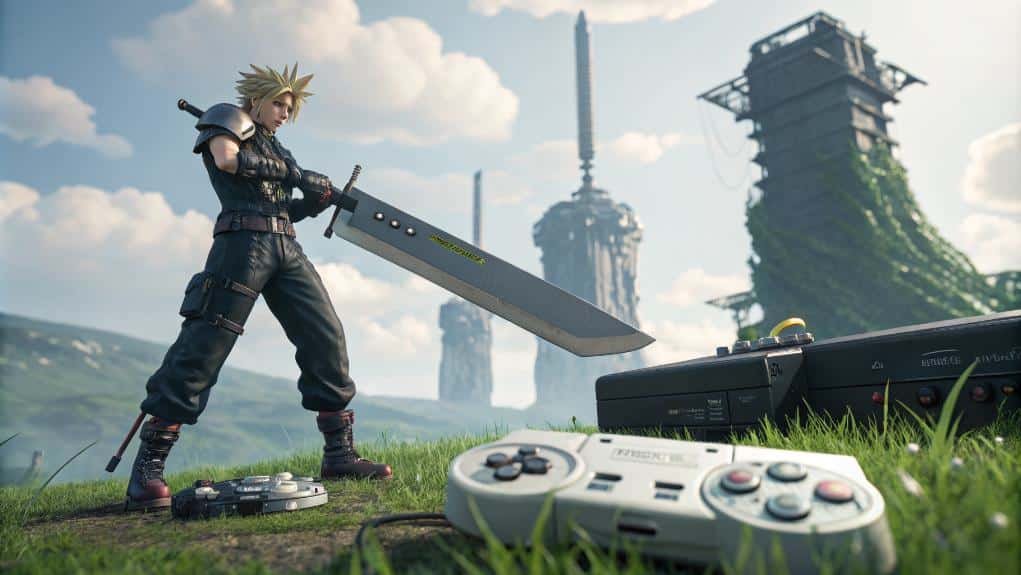
While many video games have left a mark on popular culture, few have done so as profoundly as Final Fantasy VII, which broke genre barriers and redefined the role-playing game landscape. Its high production budget and modern sci-fi setting drew mainstream audiences, challenging the negative stigma surrounding RPGs.
FFVII's rich themes of eco-terrorism and capitalist critique resonate deeply, reflecting societal concerns of the late 1990s. The game's cultural symbolism extends beyond gaming; it has become woven into intimate moments in fans' lives, such as proposals and weddings.
Nostalgia influences its lingering presence, as even those with minimal gaming knowledge recognize iconic characters like Cloud and Sephiroth. Community engagement flourished through cosplay, fan art, and music, demonstrating the game's ongoing impact.
Cross-media expansion, including films and novels, has further cemented FFVII's cultural relevance, allowing it to influence other entertainment forms. Furthermore, the subversive storytelling in the remake challenges nostalgia culture, critiquing consumerism and fandom's obsessive tendencies.
Ultimately, Final Fantasy VII serves as a cultural touchstone, illustrating the complex interplay between entertainment and societal reflection.
Legacy of the Franchise
Final Fantasy VII's legacy extends far beyond its initial release, marking a pivotal moment in video game history. The game not only revolutionized the franchise but also set a new standard for role-playing games. Its stunning 3D graphics, groundbreaking gameplay mechanics like the materia system, and engaging storytelling propelled the franchise evolution, allowing it to flourish in a competitive market.
The extensive Compilation of Final Fantasy VII showcases Square Enix's innovative merchandising strategies, expanding the narrative through various mediums, including mobile games, animated features, and novels. This approach not only retained fan interest but also attracted new audiences.
The remake trilogy, beginning with Final Fantasy VII Remake in 2020, exemplifies this continued evolution, reinterpreting the original tale for a modern audience while deepening its complexity.
The franchise's critical and commercial success has solidified its place in gaming history, influencing countless titles and popularizing JRPGs worldwide. As the universe of Final Fantasy VII expands, its rich lore and character-driven storytelling continue to resonate, ensuring that its legacy endures for generations to come.

